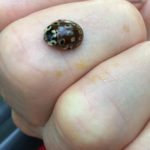
We invite members of all ages to submit questions about the natural world ranging from animals, plants, your outdoor observations, and specific questions about Baltimore Woods and our naturalists will respond!
Here’s how it works:
- Fill out the form to the left to submit a question to our education team.
- Be sure to include your first name and what area you’re from (for example – Sarah, Marcellus)
- We’ll publish your question, along with just your first name, as well as our response!
- You can read these Q&As right here in this blog post.
Answers
Hi, Patty.
I believe this is an eye-spotted lady beetle due to the white/yellow halos surrounding the black spots. As far as I can tell they are a native species of North America and prefer to live in coniferous forests where they feed on aphids.
Question:
I was just backpacking in the Sierras and there were beavers in the streams and alpine lakes we hiked past.
The lakes and flat spots were often 1-3 miles apart. How do beavers expand their territory? Do offspring walk overland to a new, suitable spot? I know they don’t like to be out of the water.
Thanks!
Ellen
Answer:
Hi, Ellen. Thank you for submitting your question!
Beavers live in family units consisting of a mating pair, young offspring, and offspring from the previous year. When a beaver turns two, they must go out in search of a place to establish a colony of their own. Beaver travel quite far in search of suitable habitat if they must, though the river you walked along must be large enough to support multiple beaver colonies. Beavers are extremely territorial, so young beaver may have swam upstream to establish a new spot, but more likely they walked. Beaver typically won’t even allow a stray adult to pass through. Beaver are not strong walkers so establishing a new colony is a very dangerous time in a beavers life!
Beaver colonies can actually take up about a half mile stretch of a river so the spacing you observed of the dams would be consistent with individual family units. They establish their territory by marking the surrounding area with scent mounds (piles of soil they leave their scent on). Beaver have been known to fight outsiders as well.
We hope this answered your question! Feel free to send questions anytime, we’re here to help!
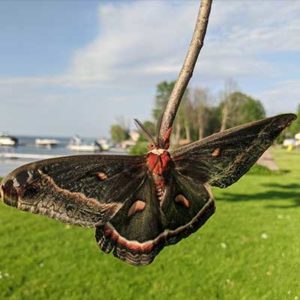
It’s interesting that you noticed three or four rusty blackbirds in Marcellus. They are a declining species, and biologists are trying to sort out the reasons for that. The most common issues are habitat loss (they breed in boreal wetlands in far northern Canada), and their winter habitats in the US are being lost to drainage and agriculture. Rusty blackbirds in the northeast US have also been found to have unusually high concentrations of mercury in their bodies. We only see rusty blackbirds in CNY during migration where they will often mix in flocks with grackles, red-winged blackbirds, and starlings. They will be most commonly found in wooded wetlands and swampy areas.
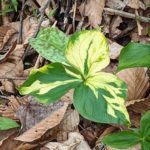 You said you found a trillium at the Skaneateles Conservation Area that you had never seen before. Thank you for sending the picture along with your question, it really helps! When leaves on a plant start to turn this yellowish color, it is called chlorosis. Chlorosis means that there isn’t enough chlorophyll in the leaves, which can be caused by a number of factors. Poor drainage, high alkalinity in the soil, nutrient deficiencies, and over or under watering. Because the veins on this trillium are green with yellow in between, I would say they are this color due to deficiency in a nutrient like iron. The trillium will probably be fine though, it looks healthy otherwise.
You said you found a trillium at the Skaneateles Conservation Area that you had never seen before. Thank you for sending the picture along with your question, it really helps! When leaves on a plant start to turn this yellowish color, it is called chlorosis. Chlorosis means that there isn’t enough chlorophyll in the leaves, which can be caused by a number of factors. Poor drainage, high alkalinity in the soil, nutrient deficiencies, and over or under watering. Because the veins on this trillium are green with yellow in between, I would say they are this color due to deficiency in a nutrient like iron. The trillium will probably be fine though, it looks healthy otherwise.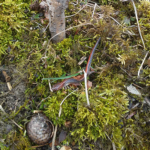 Excellent question, too. No, these salamanders actually do not have lungs. Weird right?? Since they don’t have lungs they need to live in damp or moist habitats in order to breathe through their skin, which is why they are so often found on nice cozy moist moss like your photo! We are seeing these salamanders more now due to the warm and rainy weather. They are looking for a nice damp area like under a rotting log to lay their eggs. Unlike other salamanders, they don’t need to lay their eggs in the water!
Excellent question, too. No, these salamanders actually do not have lungs. Weird right?? Since they don’t have lungs they need to live in damp or moist habitats in order to breathe through their skin, which is why they are so often found on nice cozy moist moss like your photo! We are seeing these salamanders more now due to the warm and rainy weather. They are looking for a nice damp area like under a rotting log to lay their eggs. Unlike other salamanders, they don’t need to lay their eggs in the water!This hiker noticed the tall stiff brown things with seed-like structures that are left standing when the green part of ferns die and wondered if those were a good sign that the ferns would be back.
Our Camp Director Tom Meier says: Ostrich ferns are surprisingly hardy plants that spread underground through their rhizomes. Like most ferns, they like damp soil, but too much water for too long will drown the rhizome and it will not recover. The good news is that since the Griffth’s Trail had ostrich ferns in the past, it may not be too long before new spores take hold and grow. The wet areas of the Griffith’s Trail are also home to sensitive fern, which has a persistent fertile frond where the spores are held in little bead like structures that can be seen throughout the winter. They are much more tolerant to flooding and will have no problem growing in that area. Royal ferns are also present, and are also flood tolerant. Keep your eyes out for them as spring turns into summer, there are some truly magnificent patches with fronds that are easily four feet tall!
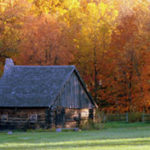
Learning to identify different egg masses in vernal pools is a great way of knowing which species are breeding there. Our top three vernal pool amphibians in Central New York are wood frogs, yellow-spotted salamanders, and Jefferson’s salamanders. Other species might use them, too, if it is a pool that doesn’t dry up completely. These could include leopard frogs and pickerel frogs. From your description, it sounds like you either found two different species’ eggs, or the eggs were just in different stages of development. Wood frogs, especially, lay their eggs in communal masses over the course of a few weeks, so it might be that the darker egg spots were more developed. Pickerel frogs have a lighter colored embryo, and their eggs are not perfectly round.
Here’s a website with great information on identifying amphibian eggs in vernal pools. I hope it helps to solve your mystery!
https://www.oriannesociety.org/faces-of-the-forest/egg-mass-identification-great-northern-forests
Yellow-spotted salamanders are carnivores. They eat mostly insects like crickets, beetles, grubs, worms, and slugs. They are not overly picky, though, if it lives underground and they can get it in their mouth, they’ll eat it!
Yellow-spotted salamanders can live as long as 20 years. They undergo a lot of changes in their first few months, hatching from an egg, then being a tiny salamander larva with gills, then quickly growing lungs and getting big enough to head up on land where they’ll spend most of the rest of their lives living underground. It’s amazing that such small animals live so long!
Sometimes water looks blueish green because there are tiny plants called algae living in the water. These microscopic plants are bluish green in color and when there are millions of them in the water the whole lake or pond will turn that color. Other times the water looks that color because of how the light is hitting the water. If your family has ever been to Green Lakes State Park, the water in the lake is bright blue or green because of how the sunlight hits the water and reflects off of minerals in the water. Here is a link to the DEC page about the lake. https://www.dec.ny.gov/
Toads have freckles and look the way they do because they are experts at camouflage. Toads are the same color as the forest floor, this means that they are camouflaged or that they can blend in with it. Next time you are hiking keep an eye out for toads, you probably won’t see them until they move because they are hidden so well.
Bark on a tree is like armor. It keeps things like bugs, bad weather, diseases, fungus, and even people from hurting the tree. However, if something does get through the bark the tree can grow new bark around the wound, like a band aid. This band aid is called a burl. That is one reason why I think trees are really cool.
White tail deer have a white tail to warn other deer if a predator is nearby. When deer think that a predator is close they make a snorting sound with their nose, as they run away they wave their tails kind of like a flag. When the other deer see it they know to run too even if they did not hear the snort. The rest of the deer’s fur is brown so they can blend in with the forest, the white underside of their tail is easily seen which makes it a perfect warning signal.
The small orange-red disks you found were definitely a type of fungus or mushroom. From how you described them and what time of year it is I think that they are scarlet cup fungus.
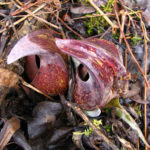
Some rocks are green because they have stuff called lichen growing on them. Lichen is green like a plant but grows and sometimes looks like fungus or mushrooms. This is because lichen is actually a plant called algae and a fungus living together. The fungus gives the algae a safe place to live and water and nutrients for it to grow. The algae gives the fungus sugars to eat when it photosynthesizes. Photosynthesis is how plants make food from the sun. The lichen on the rocks is doing an important job, it is very very slowly turning that rock into soil.



